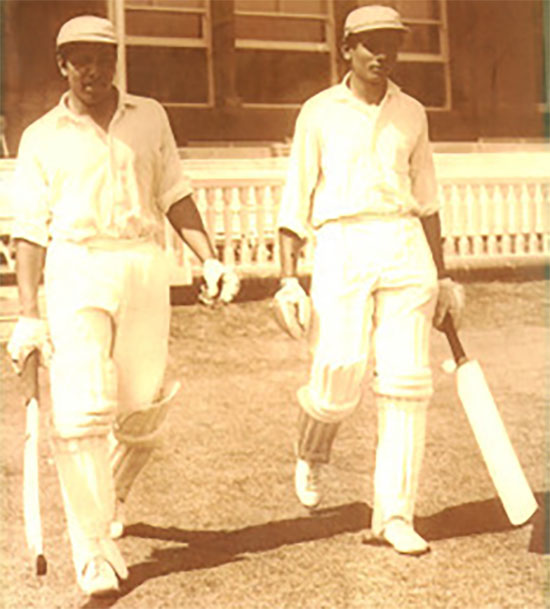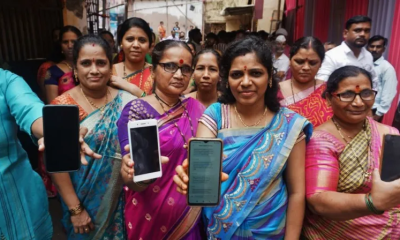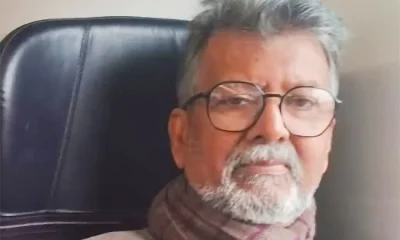Sports
The incomparable Vijaya Malalasekera

By Rohan Wijeyaratna
 It was the Royal – Thomian of 1963. Royal batting second were facing a formidable Thomian total of 254 for 8 declared. Before long they were heading for trouble at 34 for 3. That’s when a fresh-faced youngster still only 17, made his way to the middle. Before his arrival, he was subjected to a copious dousing of well-meant advice from Saliya Atapattu – a former Royal sporting personality, seated next to him in the pavilion. It was all about what must be done to avert a possible calamity, since that possibility now seemed staring Royal, squarely in the face.
It was the Royal – Thomian of 1963. Royal batting second were facing a formidable Thomian total of 254 for 8 declared. Before long they were heading for trouble at 34 for 3. That’s when a fresh-faced youngster still only 17, made his way to the middle. Before his arrival, he was subjected to a copious dousing of well-meant advice from Saliya Atapattu – a former Royal sporting personality, seated next to him in the pavilion. It was all about what must be done to avert a possible calamity, since that possibility now seemed staring Royal, squarely in the face.
Distinctly funereal
As if to confirm Saliya Attapattu’s worst fears were no stretch of his imagination, Royal were soon 42 for 4 when Tony Sirimanne (later of CR fame) snared the scalp of the Royal skipper S.S. Kumar for very little. Let alone overhauling the Thomians, getting past the follow-on mark now seemed a distant dream for the Reid Avenue boys. The Thomian attack consisted of burly Roger D’ Silva, Barney Reid, Tony Sirimanne, Panditharatne and Sarath Seneviratne, and as Cedric Fernando now wended his way to join Vijaya Malalasekera in the middle, the mood in the Royal camp was distinctly funereal, while the noise from the Thomian camp threatened to lift the pavilion rafters.
Roger D’Silva with his tail up, was bowling like the wind, and Barney Reid was doing his usual thing – bowling spin and swing with mesmeric skill and guile, out-foxing everyone standing 20 yards away. With Cedric Fernando’s arrival, everyone resigned to expect the worst.
That was when the perfect anti-climax slowly began to unravel.
Took the bull by the horns
Malalasekera -a fresh faced lad, strong of build and even stronger of temperament, wasn’t the type to die wondering. Being a cricketing buccaneer of sorts, he quickly ditched Saliya Attapattu’s well meant advice, no sooner he got up from his pavilion seat. Deciding instead to take the bull by its horns, Malalasekera cut loose with an array of stinging square cuts, drives, pulls and hooks, against Roger D’ Silva’s menacing pace. Then he proceeded to nullify Barney Reid’s nagging accuracy, guile and cunning, by unleashing an array of strokes of such breathtaking fury, they were now being wildly cheered by even those in the Thomian camp, who by then had reached an advanced state of inebriation and didn’t know who was doing what. Noisy pavilion banter argued whether or not this was the most furious innings ever seen at a Royal-Thomian. Let there be no mistake; this was no exhibition of vulgar village green hitting. Instead, it was fearsomely orthodox stroke play, executed with immense power and precision. In short, it was reminiscent of an Everton Weekes’ innings when in full flow. Some of Vijaya’s drives to the cover boundary were of such ferocity and force, the ball would hit the short parapet wall at the front of block C or D at the Oval, and ricochet right back to the actual playing strip! Thanks to this unprecedented assault, Malalasekera reached a sensational hundred in just two hours and 10 minutes on either side of lunch on day two. That innings which contained 20 fours and one six turned the flow of the game on its head, and to date ranks as one of the most fiercest exhibitions of sustained hitting ever seen in the entire history of the Royal-Thomian. Shortly after that blitzkrieg, Royal declared at 207 for four.
Hadrian’s wall
Throughout it all, Cedric Fernando served as the perfect foil for Vijaya, presenting a bat which rivalled Hadrian’s great wall beyond which no ball could pass. No amount of praise would do him justice for the role he played in this gallant partnership. Although playing second fiddle, Fernando played a stellar role in the proceedings and at the declaration was unbeaten on 47. Malalasekera remained unbowed on 112,whilst playing the innings of his life.
Never a selfish cricketer
Vijaya Malalasekera was never a selfish cricketer. Instead, he was a supremely confident young man with a cavalier bent, ready and willing at all time to back his own instincts. Not in a conceited way, he was cocky up to his eye-lashes, of his own abilities. It was not in his character to tailor his innings to make good his promise to his parents, that should they come down from London to witness the match, he would make a hundred. Grapevine rumour has it that the father in a moment of light headed recklessness had responded saying that in that event, he would secure his son a seat at Cambridge. Being Ceylon’s Ambassador in England at the time, there was not a lot Gunapala Malalasekera could not do, given the esteem in which he was held in those parts. But Vijaya being Vijaya and therefore hugely popular and totally out-going in a literal and metaphorical sense, had little time for study whilst at Royal. As things panned out Vijaya secured his place at Cambridge after acquiring the necessary entrance requirements in England. The story heard through the grapevine of his father’s promise to get him to Cambridge in return for a ‘big match’ hundred may be or mayn’t be true, but it is a good story and therefore shall be retained. What is definitely true however, is that his sporting stock rose considerably after his ‘big match’ performance and tilted the scales in his favour, when the prestigious ‘Schoolboy Cricketer of the Year’ award was announced. That was a fitting culmination to a terrific season for this hugely popular, fun loving young man.
On the strength of that one inning Vijaya Malalasekera was included in the Colts XI which played the University in a crucial game which would decide the Sara Trophy champions for that year. Malalasekera played a brief but trademark innings as Colts got the better of their opponents who went on to win the championship on points. That was the only Sara trophy game Vijaya played in Ceylon, before proceeding to England to join his parents. With his departure, he forewent the Royal College captaincy the following year.
Having fulfilled the entrance requirements and charmed his way past the Admissions Tutor at Fitzwilliam College in Cambridge, Malalasekera was in like a breeze and allowed to read for a degree in Law in 1966.
Murray asked to leave
Much like Lorenz Pereira of a slightly earlier vintage and quite predictably, Vijaya enjoyed his life at Cambridge to the fullest. So did one Deryck Murray, who kept wicket for the West Indies and captained the Varsity at cricket in 1965 and 1966. Murray took an instant liking to Vijaya, both for his style of batting and his approach to life. In fact, Murray tended to enjoy himself so much, he was kindly asked to leave the University by the end of his second year whilst being Captain of Cambridge! The social life at Cambridge seemed irresistible to some, and a source of immense distraction to cavalier cricketers, who were unwilling to have their noses constantly pore over their books while the bright lights beckoned. In Malalasekera’s first year (1966) while batting at No 6, he played 24 innings in 13 first class matches, making 323 runs with a highest score of 80 at an average of 13.45. Against Essex in his very first match Vijaya batting in the same vein as his ‘Big Match’ innings of 1963, pummeled a brilliant 80 against the likes of Barry Knight, Robin Hobbs and Ray East, and against Northants, he made an attractive 72 teaming up with Deryck Murray to record the highest Cambridge total for the season. But as Wisden pointed out, “….. V.P. Malalasekera from Ceylon, flattered only to deceive too often.” All told, Cambridge enjoyed a poor season in 1966.
Peter May’s admiration
Having enjoyed a reasonably successful first year, Malalasekera failed to become an automatic choice the following year as his magical form deserted him. Consequently, and much to his chagrin he was left out of the Cambridge side, and was playing for the Fitzwilliam College XI instead; a crushing blow to a young man’s ego. However, in the annual Cambridge University v Quidnuncs (former Cantabrigians) fixture, Steve Russell, the Cambridge captain invited Malalasekera to open batting with All-Ceylon opener Mano Ponniah, who had by then, just joined the Varsity.
Stung by the fact that he was dropped from the Varsity team, Malalasekera on his way to the middle, somewhat nervously asked Ponniah not only to take first strike, but also to ‘take it easy’ against Test opening bowler Richard Hutton, who was tasked to open the proceedings. Ponniah taking first strike promptly forgot his solemn promise and gleefully took a single off the very first ball to get off strike. This brought Vijaya Malalasekera to face England Test paceman Richard Hutton, now in his prime.
As Ponniah recalls, nervousness was plainly visible on Vijaya’s face. In fact, his face seemed whiter than Hutton’s! That was before the ball arrived. It came at a screaming pace and left at a screaming pace. In-between, Malalasekera had leaned into it and stroked it superlatively on the up with such sublime timing and placement, the ball vanished like a startled banshee, gathering speed as it went. This was such a spectacular strike through the covers, Peter May standing at first slip could not resist applauding, and as he crossed to change ends at the end of the over, he stopped and asked Vijaya for his 2 lb 2 oz bat to have a closer look at it. Peter May the ex- English captain was renowned as one of the hardest strikers of a cricket ball in England in his glory days of active cricket.
 Cambridge team pictured besides the Grace Gates at Lord’s. Vijay Malalasekera seated front row extreme right and Mano Ponniah standing second from right.
Cambridge team pictured besides the Grace Gates at Lord’s. Vijay Malalasekera seated front row extreme right and Mano Ponniah standing second from right.
The first Asians to open for Cambridge
For the record, Mano Ponniah and Vijay Malalasekera were the first Asians to open for Cambridge in the Varsity game of 1967. This was Ponniah’s first year at Cambridge. Vijaya missed playing in the entire 1968 season, thanks to a troublesome shoulder injury.
Completing his degree the following year, Malalasekera proceeded to Law College, where he passed his Law exams in 1970. Reading his name on the notice board one day, he was so thrilled, he ran all the way to his erstwhile friend Gijra Rajapakse’s digs to break the news and proceeded to ring all known Sri Lankan friends to come along to London House to fittingly celebrate his success!
Chose his friends wisely
Unsurprisingly, Vijaya– at least outwardly -was a strong Buddhist. He was also an internationalist in every sense of the word. He saw no division amongst religions; a fact driven home by his marriage to Niri – a strong catholic. Gijra Rajapakse was the Bestman at the wedding. The story goes that Gijra, walking alongside Vijaya just seconds before they entered the church together, whispered in his ear “Malalasekera, the car is outside; in case you change your mind”. There was no gain saying Vijaya chose his closest friends wisely!
Among the hand luggage he carried with him on his way back to Ceylon was a book on Buddhism picked up on the way. Knowing that it was very likely his parents would be at the airport to greet him, Vijaya carried the book prominently in his hand to impress his father in particular, who was a leading light in Buddhist affairs back in Ceylon. The tactic some say, worked wonders!
Nearly decapitated….
On his return, Vijaya played a few Sara Trophy games for the NCC and then shifted to the CCC where he played some Daily News cricket. Mahen Dayananda of the CCC who shared many a partnership with him recalls walking up to Malalasekera and pleading with him on one occasion to hit his straight drives not so straight, lest he be decapitated at the non-striker’s end!
Malalasekera tried his hand at practicing law but soon decided to join the private sector instead. Shortly, he was heading the legal Department at Ceylon Tobacco Company, and ended up as its Corporate and Regulatory Affairs Director. Upon his retirement he was invited to join several other companies as a Board member, since his expertise, experience and knowledge on good governance were in high demand, and valued by many.
The first two Interim Committees
Following gun fire at the Cricket Board AGM in early 1999, President Chandrika Kumaratunge dissolved the Board and installed the first Interim Committee, headed by Rienzie Wijetilleke. That Committee came across as a breath of fresh air into the musty cricket administration at the time. However, they functioned for less than one year from June 1999, resigning from their posts in May 2000, owing to continual political intrigue exercised by those who should have known better. Not before long, the Cricket Board was again mired in controversy, necessitating higher powers to intervene. Possibly because she knew him personally and trusted in his ability and sincerity, Vijaya Malalasekera was appointed by President Chandrika Kumaratunge as Chairman of the second Interim Committee of the cricket Board in 2002. He accepted, but not before making it quite clear that he wished her to always fully back his judgment, failing which he would be gone. To her eternal credit, President Kumaratunge kept to her word and respected the understanding. Appointed alongside him were Michael Tissera, Sidath Wettimuny and Kushil Gunasekera, in what was one of the most productive and efficient Interim Committees the Board had ever known.
During Vijaya’s tenure, Sri Lanka registered a record ten straight Test wins under Sanath Jayasuriya’s captaincy. At least a part of that success must be credited to Vijaya’s leadership and methods of governance. He led by example. He was clear cut, forthright, bold and fearless in his decision making. Yet he was non interfering. He set an example and displayed sterling qualities of leadership. This trend cascaded to each rung below. He strongly believed a leader is only as good as his team. Men of proven worth and capability were invited to serve on the various sub-committees, and they were allowed to utilize their expertise and work without hindrance. Alas, that Interim Committee too wasn’t destined to remain long in office. In the political upheaval of late 2002, the Ministry of Sports went into the hands of a different ruling political faction and Vijaya Malalasekera for no valid reason was removed from his post as a consequence. That was the end of one of the most productive spells of cricket administration in this country.
Walked with Kings ……
Fun loving and friendly by nature, Vijaya Malalasekera was comfortable in any crowd, be it royalty or men from the street. He could – as the poet said – walk with Kings, yet not lose the common touch. Although a colourful cricketer and a ‘character’ in his own right, he proved in a spell of less than one year, that his greatest contribution to the game could have been through its administration. It was to the eternal misfortune of this country that it failed to use him considerably more, than it actually did!
Latest News
Henry, Santner, Nathan Smith ruled out of rest of West Indies Test series

New Zealand’s bowling spearhead Matt Henry (calf strain), seam-bowling allrounder Nathan Smith (side strain) and spin-bowling allrounder Mitchell Santner (groin injury) have all been ruled out of the rest of the home Test series against West Indies.
Glenn Phillips, who joined the squad in Christchurch early as a substitute fielder, has officially been added to the Test squad for the remainder of the series, New Zealand Cricket confirmed. This after he proved his match fitness in the Plunket Shield before joining the squad for the first Test, and he could be in contention to be selected in the XI for the second Test.
In another bit of good news for New Zealand, Daryl Mitchell, who put in a long shift as a substitute fielder in the first Test, is set to be available for the second and slot back in as their middle-order mainstay.
Wicketkeeper-batter Tom Blundell had already been sidelined from the second Test in Wellington after suffering a hamstring injury while batting on day one in Christchurch. Mitchell Hay has been added to the squad and could make his Test debut.
Also, a day after uncapped seamer Michael Rae was called up to the Test squad, Kristan Clarke, a seam-bowling allrounder from Northern Districts, was added to it. With Kyle Jamieson and Will O’Rourke managing “return to play” protocols, New Zealand were left scrambling for last-minute replacements, with the Wellington Test set to begin on November 10.
Both Rae and Clarke were pulled out of the third round of the Plunket Shield. Clarke didn’t bowl for ND in the final innings against Otago in Hamilton, with rookie James Naylor stepping in as his replacement.
Clarke, 24, is uncapped in Test cricket, but was recently part of the ODI series against England as a replacement player after Henry had suffered a separate calf injury. He has now earned his maiden Test call-up as a like-for-like replacement for Smith.
“On the cricket field, I’m a bowling allrounder, you know, and I pride myself on trying to offer as much as I can in the game,” Clarke said in October after breaking into the ODI side. “I just want to be a good person around the group also and just offer as much as I can.”
Clarke has played 27 first-class games so far, taking 77 wickets at an average of 33 and scoring 893 runs at an average of 23.50. He was also part of a New Zealand A tour to Bangladesh during the winter. Though bowling is his primary skill, Kristian is also a capable batter and had notched up his maiden century in senior cricket, against Central Districts in the one-day Ford Trophy, in October.
Clarke hails from Te Awamutu, a small town in the Waikato region and played for Waikato Valley in the Hawke Cup before rising up the ranks in New Zealand cricket. His brother Matti Clarke has also played for Waikato Valley in the Hawke Cup.
“Yeah, so [I was] born and raised in Te Awamutu, [and I] still live in Te Awamutu, still at home,” Clarke said. “I hold Te Amuru very dear to my heart – it’s a cool little town and yeah, quiet little place. Just sort of grew up through the cricket system there and then yeah, sort of just went from there.”
While Blair Tickner, who was the reserve seamer at Hagley Oval, comes into the selection frame for Wellington, there might be a toss-up between Rae and Clarke for a potential Test debut at Basin Reserve.
The first Test was drawn after West Indies, faced with a 530-run deficit in the fourth innings, held on for 163.3 overs to pull off a draw, with Justin Greaves (202 not out) and Shai Hope (140) their main men with the bat
New Zealand squad for second Test vs West Indies :
Tom Latham (capt), Devon Conway, Kane Williamson, Will Young, Rachin Ravindra, Daryl Mitchell, Glenn Phillips, Mitchell Hay (wk), Michael Bracewell, Zak Foulkes, Jacob Duffy, Blair Tickner, Michael Rae, Kristian Clarke
[Cricinfo]
Sports
Van Niekerk cameo, Tunnicliffe fifty give South Africa series win

Dane Van Niekerk’s late blitz on the back of a sedate half-century from Faye Tunnicliffe helped South Africa beat Ireland by 65 runs in the second T20I in Paarl and take an unbeatable 2-0 lead in the three-match series.
Opting to bat, South Africa racked up 201 for 5 in their 20 overs. In reply, allrounder Orla Prendegast scored an unbeaten 43-ball 51 while Leah Paul hit 40 off 29 balls, but Ireland could only manage 136 for 3, falling well short.
In her comeback series, van Niekerk thrashed a 19-ball 41 in the back half of the first innings, taking South Africa past their second consecutive 200-plus total of the series. She struck three fours and three sixes in her knock. By the time van Niekerk fell to Arlene Kelly, South Africa’s run rate had jumped past ten an over. Chloe Tryon’s unbeaten seven-ball 16 in the final overs took them to 201, as she also broke Lizelle Lee’s record for most sixes by a South Africa batter in women’s T20Is (49).
Van Niekerk’s cameo complemented a slower – but equally crucial – knock by Tunnicliffe at the top of the order. She reached her maiden T20I half-century off 40 balls: the majority of her innings was played alongside fellow opener, Sune Luus, as the two put up a 78-run opening partnership to lay the foundation.
Aimee Maguire dismissed both of them, as well as captain Laura Wolvaardt, returning 3 for 43 in her four overs.
Ireland’s batters were slow in their response, scoring 33 runs in the powerplay despite losing no wickets. Tryon sent back both openers – Amy Hunter and Gaby Lewis – as Ireland were reduced to 35 for 2 in the seventh over.
Their run-rate never picked up, but Prendergast and Paul stayed solid in the middle to share a 76-run partnership for the third wicket. Paul finally fell for 40, but Prendergast stayed around till the end to bring up her half-century in the final over, off 39 balls. By then, the result of the match was a foregone conclusion.
Brief scores:
South Africa Women 201 for 5 in 20 overs (Faye Tunnicliffe 51, Sune Luus 37, Laura Wolvaardt 22, Dane van Niekerk 41, Marizanne Kapp 16, Chloe Tryon 16*; Orla Prendergast 1-29, Arlene Kelly 1-40, Aimee Maguire 3-43) beat Ireland Women 136 for 3 in 20 overs (Amy Hunter 14, Gaby Lewis 19, Orla Prendergast 51*, Leah Paul 40*; Nonkululeko Mlaba 1-25, Chloe Tryon 2-24) by 65 runs
[Cricinfo]
Sports
Nissanka, Vince continue Gulf Giants’ unbeaten start

Pathum Nissanka continued his good form in the ILT20 with 67 off 31 balls, to give the Gulf Giants their second win in as many games in the competition as they beat the Dubai Capitals. James Vince anchored the innings with a composed 45-ball 50* as the Giants chased down the target of 161 with four wickets to spare.
With the Capitals having been put in to bat, they began with a boundary in each over but Azmatullah Omarzai got Shayan Jahangir to chop one back onto his stumps. After four quiet overs, David Willey and Sediqullah Atal slammed a six each off the Afghan fast-bowler to bring some oomph into the innings. The duo put on a 61-run stand in seven overs before Atal miscued a pull off Moeen Ali to deep mid-wicket.
The wicket ensured Moeen and Liam Dawson could fire in a couple of quiet overs before the latter picked up the set David Willey. Ayaan Khan scalped Gulbadin Naib in the next over as the Capitals fell to 93/4 in 14 overs. Jordan Cox slammed two sixes and two fours in a quick 17-ball 31 and found success against fellow Englishman Moeen to get the Capitals’ innings moving. But the brakes were once again applied, when Cox and Rovman Powell fell to Omarzai in the 18th over.
Looking for a strong finish, Dasun Shanaka pulled Omarzai over fine-leg for four before smashing two sixes on the offside, in an 18-run final over, to take the Capitals to 160 for 6 in their allotted overs.
In reply, Rahmanullah Gurbaz survived a review in the first over and then slammed David Willey over mid-wicket for six before falling to a stunning catch by Cox. Nissanka, who had scored 81 in his last game, took a liking to Mustafizur Rahman with a boundary down-the-ground and a six over mid-wicket to get his innings moving.
The Sri Lankan then smashed James Neesham for 22 runs in the fifth over flat-batting two sixes and a four along with a maximum down the ground. Vince hit two boundaries off Mustafizur as they raced to 60 for 1 at the end of the PowerPlay. He was also dropped by Willey as the Capitals began to look poor on the field.
Nissanka hit consecutive boundaries in the 10th over to bring up his 50 of just 23 balls. He then slammed Waqar Salamkheil for two fours and a six in a 15-run 11th over as the Giants continued to cruise to victory. He was finally dismissed by Mustafizur after failing to hit one over Cox’s head at long-on.
Towards the end, there was a flurry of wickets but Vince stood firm at the other end bringing up his 11th fifty of the competition and taking his team home.
Brief Scores:
Dubai Capitals
160/6 in 20 overs (Sediqullah Atal 35, Jordan Cox 31; Azmatullah Omarzai 3-46)
Gulf Giants
161/6 in 18.5 overs (Pathum Nissanka 67, James Vince 50*; Dasun Shanaka 2-16) (cricbuzz)
-
News6 days ago
Lunuwila tragedy not caused by those videoing Bell 212: SLAF
-

 News1 day ago
News1 day agoOver 35,000 drug offenders nabbed in 36 days
-

 News5 days ago
News5 days agoLevel III landslide early warning continue to be in force in the districts of Kandy, Kegalle, Kurunegala and Matale
-

 Business3 days ago
Business3 days agoLOLC Finance Factoring powers business growth
-

 News3 days ago
News3 days agoCPC delegation meets JVP for talks on disaster response
-

 News3 days ago
News3 days agoA 6th Year Accolade: The Eternal Opulence of My Fair Lady
-

 News1 day ago
News1 day agoRising water level in Malwathu Oya triggers alert in Thanthirimale
-

 Midweek Review6 days ago
Midweek Review6 days agoHouse erupts over Met Chief’s 12 Nov unheeded warning about cyclone Ditwah



















